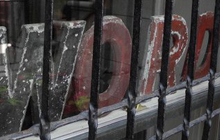A much appreciated appreciation.
Neither my friend Tiffany nor I are originally from Harlem, but both of us take pride in having made it our adopted home. We both like to explore its streets, meeting people and seeing things, taking the measure of its beauty and strangeness. It’s Tiffany who showed me that if you take the C to 163rd St, and then walk across the bizarrely perfectly-preserved Gilded Age enclave that is Sylvan Terrace (hidden gem), and then turn on Jumel Terrace and walk past the oldest house in Manhattan, Morris Jumel Mansion (hidden gem), and then turn again on 160th St and walk west on the south side of the street, you will encounter a small basement-level window filled with books and four big wooden letters: W-O-R-D. This is Jumel Terrace Books, yet another hidden gem in Harlem. (Some would say that this is not in Harlem but rather in Washington Heights. Discussing what-is-where is a favorite New York pastime. This particular little patch of Manhattan is a bit of a no-man’s land, claimable by Harlem and the Heights both. Few people in either neighborhood even know it exists, so really it mostly goes unclaimed.)
On a recent weekday morning in late August, Tiffany and I, together with my younger son Seiji and photographer Mike Nogami, made the trek to 426 W. 160th St. We knocked on the basement door (“Open by appointment, invitation, or serendipity”) and were admitted by the owner, Kurt Thometz. Walking into Jumel Terrace Books is like walking into a small museum, or a large wunderkammerer. There are all manner of tchotchkes, figurines, postcards, posters, paintings, Art. And of course, books. Packed into the shelves lining the walls, and stacked on every surface, books upon books upon books. The store specializes in “Revolutionary & Colonial Washington Heights, Harlem, Africa, West Indies, Art, Myth, History & Literature: Slavery, Reconstruction, Jim Crow, Theology, Military, Labor, Civil Rights, Negritude, Black Power.” Look closely at that description. What does it even mean? It’s hard to know. All I can tell you for sure is that this place is full to the brim with books that you don’t have. (And maybe a few that you do, too.) There are large, glossy photography books and yellowing, crumbling paperbacks; biographies, histories, polemics, potboilers. The range of available knowledge is stunning, humbling. What can one even say when faced with such an enormous repository of wisdom?
Actually, happily, Kurt has a lot to say. He always has a lot to say. He is a romantic, a rambler, a raconteur, and he doesn’t really stop once he gets started. Today, that’s fine by me. I sit with pen in hand, and I listen.
After moving to New York from Minnesota in 1974, Kurt became involved in the scrappy East Village art scene (think Basquiat and Haring) as well as the burgeoning hip hop and graffiti scene (think Wild Style). He also began working as a private librarian to the wealthy, cultured classes – Diana Vreeland was one of his first clients. After years of exile downtown and in Brooklyn, he finally moved with his wife, the couturier Camilla Huey, to his psychic home in the city, Harlem. If you can come home to a place where you have never lived, well, that’s what this was like. Indeed, one of the first places in the city that Kurt visited back in 1974 was this very neighborhood – Sugar Hill – to see where Ellington had lived. There were goats and chickens in the alleys and boogaloo coming out of the windows, and no one knew the name Ellington.
Of course plenty of native Harlemites know who Ellington is, especially these days, now that he’s History, but we still suffer from certain lacunae around here. Harlem has some of the lowest reading scores in the country, and whatever you think of reading tests and scores (as for me, NOT MUCH), we can probably all agree that this is not a sign of anything positive. That’s partly why Kurt decided to open a book store in the basement level of his new house. “I wanted to take my own little stand,” he explains. “I started by just filling the space with all of my own personal Black Studies books. I had already read them anyway, and I wanted to contribute to my new neighborhood by creating an information-intense environment. There’s not much of that around here. Even when you walk into the Schomburg [Center for Research in Black Culture, the NYC Public Library’s flagship Harlem location], there are no actual books.”
Kurt feels strongly that actual, physical books – words printed on bound paper – are irreplaceable keys to enlightenment in our modern world. He is a true believer: he has seen the literally transformative power of books with his own eyes. Kurt’s son (by his previous marriage) was born severely autistic, with profound language and communication delays that were evident from almost the very beginning, and Kurt was for all practical purposes his sole caregiver.
“Reading,” Kurt said, “is the most important thing a parent can do. So many other parental responsibilities are merely custodial. But when you read, you’re sharing with your child what you know and how you came to know it. Also, at the time, I was thinking a lot about Africa, and how the introduction of the written word there irrevocably changed people’s consciousnesses. And so I read books to my son as much as I possibly could. Every single opportunity I got, I’d sit with my son in the crook of my arm, like you’re holding your child now, and I’d read to him. For years, there was no recognition. But then one night, when he was five years old, I was reading him a Thomas the Tank Engine book, and I missed a word. I read the phrase, ‘Henry the engine,’ and my son said ‘GREEN’ – as in ‘Henry the GREEN engine.’ This was the first non-echolalic, non-gibberish utterance he had ever made in his life. Soon, he was copying out his favorite books onto the computer, and by the end of that summer, we had written a poem together.” Kurt’s son has now fully emerged from the shell of autism, and Kurt credits the presence of books in their life together.
As important as books are to his personal life, Kurt feels that they are also of particular import here in Harlem. “Digital media is not the same,” he insists. “Print on paper is tangible, real. And that’s crucial here – Harlem has always valued actuality and realness. Harlem’s reputation has always been for authenticity. It’s always been what people say about Harlem, and what Harlem says about itself: ‘Harlem is really real.'”
The exhibit is mysterious and enticing. Like Jumel Terrace Books, the individual pieces spill over with printing and writing and paper; like Jumel Terrace Books, they feel familiar and intimate while also resonating with the enormous immeasurable reaches of wisdom and history. None of us quite knew what to say, so we were mostly quiet, our footsteps echoing on the worn wood floors.
On the train home, my mind was tumbling with thoughts of books and writing, men and women, children and parents, history and revolution, wisdom and knowledge. These things – the Big Ideas – had been on my mind a lot recently anyway. In my previous Sling Diary, I outed our family as unschoolers, and the process of confession and justification forced me into thinking carefully about what I believe about life, about growth, about people, about what is really important. I’ve had to think about teaching and learning, too. How does knowledge happen? How do we create it? How do we help people become what we want them to be? Is it even correct or useful to wish people to be anything in particular in the first place?
These questions are necessarily central for parents who make any sort of unusual choices for their children (as, incidentally, Tiffany, Mike, Kurt, and I have all done to one degree or another). But really, these questions are at the heart of the project of all parents everywhere: What do I want my children to know and to do, and how shall I get them there? Often, one takes oneself as the negative example. Like: these are the things that I don’t like about myself and/or my upbringing, so I will make it so that my kid doesn’t have those things. That was the basic model of thinking that I had been using myself, without quite seeing it. On the train home, though, on the C train down through Harlem from Jumel Terrace Books and The Loves of Aaron Burr back to my apartment, I saw it clearly, and I saw that it was not quite right.
There are certainly innumerable aspects of my personality and my being that I do not wish to recreate in my children, but sitting on that Harlem train, I saw the reality that I am in a few important ways the precise type of person that I’d like my children to be. I am questioning, independent, and individual, and I am faithful in my pursuit of a coherent personal vision. I do not know how my parents came upon the wisdom that allowed this to occur, but somehow they did. They made some mistakes, too, a few of which were significant and which I prefer not to repeat. I’m sure that my children will say the same of me, and their children of them. That said, given that I am myself, and that some of the central qualities of me are qualities that I value in other people, it must be that my parents got a lot of things – maybe even most things – right.
It seems, then, that the only way to keep it real here is to retroactively dedicate this entire cycle of Sling Diaries to both of my parents, who, for better or for worse, had the wisdom to make me into the woman who was able to write them.
All photographs by Mike Nogami. Featuring the Sakura Bloom Single-Layer Luxe Silk Sling in Jade.
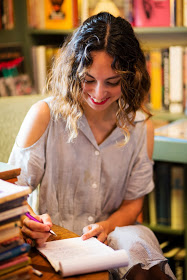


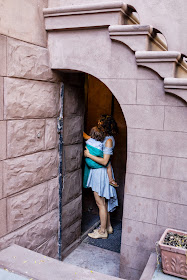


















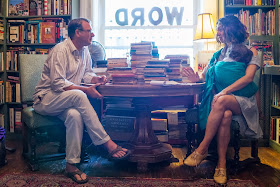







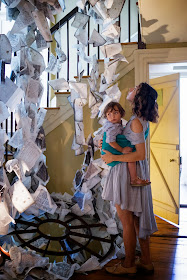





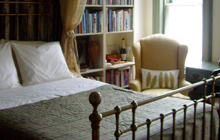 Jumel Terrace B&B
Jumel Terrace B&B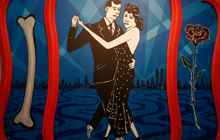 Life Turns Man Up & Down
Life Turns Man Up & Down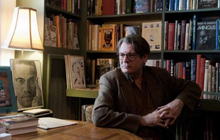 The Private Library
The Private Library